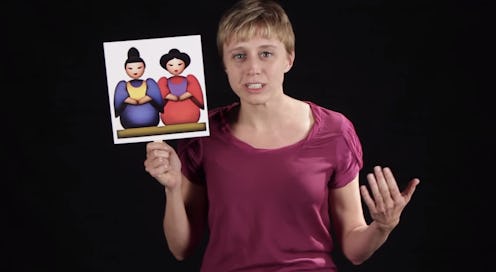
While emojis have become an integral part of the way we communicate, text, and even think (admit it, the heart-eyed cat emoji is relevant ALL the time), there is still a large demographic of people in this world who don't seem to have a grasp on the nuances and intricacies of emoji use: grown-ups. Buzzfeed asked a group of adults to explain emojis, emoji use, and even emoji history. Whether they felt emojis were fascinating, confusing, or worthy of ridicule, all these adults had something to say, ranging from "I think they're the greatest thing to happen to the English language" to "I don't personally use emoji...because I'm a 36-year-old man" to "They're dumb."
According to the video, emojis can be traced back to the 1990s when people who had docomo phones in Japan could send and receive emojis to one another. The trend was limited to Japan, but about 20 years later in 2011, when Apple added a standardized emoji system to iOS 5, the emoji started to become popular in the Western world. In this video, adults try to explain what a variety of emojis mean including the Japanese dolls ("They're very clearly birds disguised as ladies"), the pile of poo emoji ("You wanna keep talking to the person, but you don't have anything left to say so you throw a poop emoji in"), and my personal favorite, the see-no-evil-monkey ("Listen, I'm going to send you a picture but don't look at it in front of your co-workers").
While these are great emojis to dissect and tackle, I could personally use more explanation about some of the more ambiguous ones, like the face with no mouth, the purple devil, or the tank-top that seems to have an arbitrary sash on it. But what it comes down to at the end of the day is that maybe emojis don't have just one, uniform meaning and instead we can assign them whatever simple, cute, inappropriate, or vulgar meaning our hearts desire.
Images: Buzzfeed